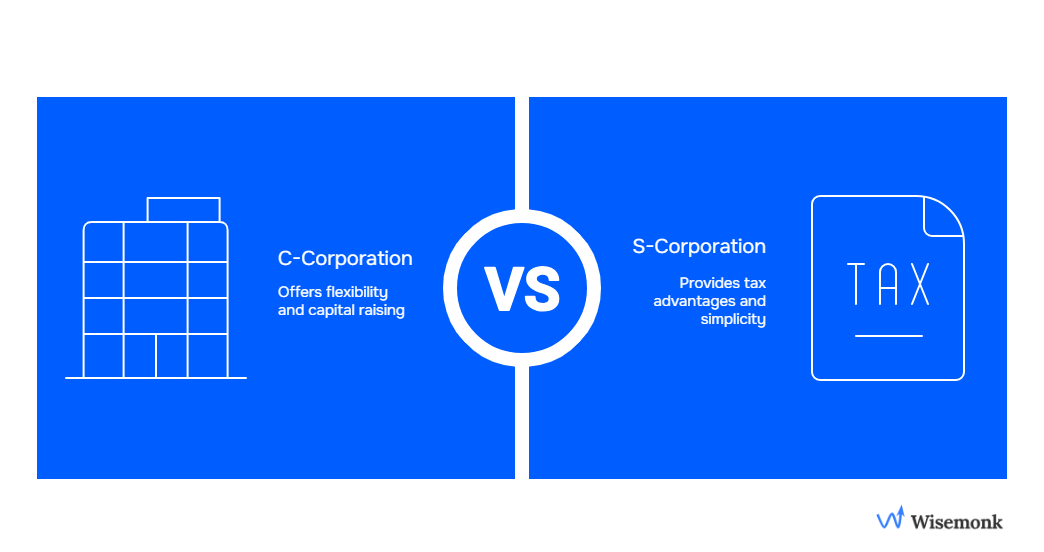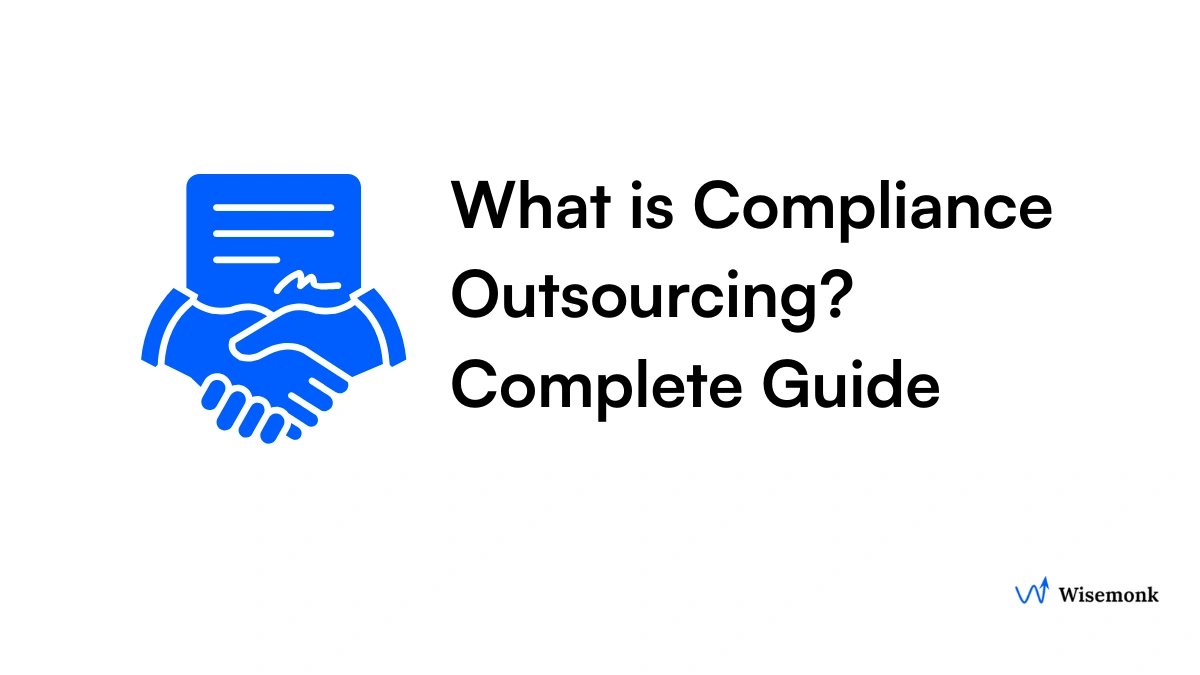- A corporation is a distinct legal entity and a legal entity separate from its owners (shareholders) that offers limited liability, can issue stock, and has perpetual existence.
- The advantages of a corporation are that owners’ personal assets are protected from business debts, it’s easier to raise capital, and the business enjoys perpetual existence, even as stock ownership.
- The disadvantages of a corporation include double taxation, increased legal obligations and annual reports, and administrative complexity compared to other business structures like limited liability companies (LLCs).
- Key differences are that C corporations have double taxation and allow unlimited shareholders, while S corporations avoid double taxation but have stricter limits on shareholders and stock classes.
Have questions about choosing the right corporate structure? Reach out to us.
Discover how Wisemonk creates impactful and reliable content.
Introduction: Understanding Corporate Structure[toc=Introduction]
Are you wondering what the real advantages and disadvantages of a corporation are? Business entities include sole proprietorships, partnerships, LLCs, and corporations, each offering different levels of liability protection, flexibility, and formality. For a breakdown of how these affect your workforce and operations, see our article on workforce optimization examples & benefits.
Incorporate if you want to raise major investment, separate personal and business liabilities, ensure business continuity, or boost credibility. It's ideal for growth-oriented businesses or those seeking investors.
A corporation boosts growth by making it easier to raise capital, attract investors, and operate efficiently with formal governance.
This article highlights the main advantages and disadvantages of corporation structure to help you decide what’s best for your business.
Advantages of Corporation Structure[toc=Advantages]
Based on our extensive experience providing global payroll services, we have seen how selecting the right corporate structure can significantly streamline HR processes. Here are the key corporate structure benefits and advantages of corporations:
Limited liability protection:
Corporations protect owners’ personal assets, only the invested capital is at risk in the event of business debts or lawsuits. This protection is crucial for founders and investors, especially as a company grows or expands globally.
You can read more about the importance of compensation management and liability protection for modern businesses.
Easier access to capital and investors:
Corporations can raise substantial capital by issuing shares or stock, attracting venture capital, and even becoming publicly traded corporations on stock exchanges like the New York Stock Exchange.
Tax planning:
Corporations often benefit from certain personal tax benefits, more favorable federal and state taxes, and tax advantages that help optimize business income.
Perpetual existence and transferability:
A corporation continues indefinitely, no matter who owns it; shares can be transferred easily, simplifying succession and business ownership transitions.
Enhanced credibility and prestige:
Corporate status signals professionalism and regulatory compliance. It builds trust with customers, investors, partners, and helps attract top talent.
Disadvantages of Corporation Structure[toc=Disadvantages]
Based on our current research and industry insights, here are the main business incorporation pros and cons, focusing on the disadvantages of choosing a corporation as your business structure:
Double taxation issues:
C corporations pay taxes on profits, and shareholders are taxed again on dividends. Not all businesses qualify to avoid this with S corporation status.
Increased regulatory compliance:
Corporations must file annual reports, hold annual meetings, and meet specific legal obligations, requirements that nonprofit corporations and other business structures may avoid.
Administrative complexity and costs:
Higher state filing fees, compliance costs, and more paperwork add financial implications for small business owners or those considering forming a corporation.
Get practical advice from our guide on HR legal compliance best practices.
Loss of operational flexibility:
Formal processes and board approvals often slow decision-making compared to more flexible LLCs or partnerships. Quick strategic shifts can be more difficult to execute.
Ongoing filing requirements:
Corporations must file frequent, detailed reports at federal, state, and sometimes local levels.
Missing deadlines or errors can cause fines or a loss of good standing, especially in multi-state or global operations.
C-Corporation vs S-Corporation[toc=C-Corp vs S-Corp]
Drawing from our extensive experience in supporting businesses with operational compliance, we have explained the key differences between C-corporations and S-corporations here.

C-Corporation :
A C corporation is a standard corporation recognized as a separate legal entity from its owners (shareholders). It provides limited liability protection, the ability to raise capital through an unlimited number of shareholders (including foreign investors), and exists independently of its owners. However, it’s taxed at both the corporate and shareholder levels known as double taxation.
S-Corporation :
An S corporation is a special type of corporation that, by meeting specific IRS requirements and filing Form 2553, is granted “pass-through” tax status. This means corporate income, losses, deductions, and credits are passed directly to shareholders and reported on their personal tax returns. S corps have strict ownership limitations and can issue only one class of stock.
Here are the main differences between S-corporation and C-corporation, for easy comparison:
Corporation vs Other Business Entities[toc=Corporation vs Other]
Choosing the best business structure is key to achieving your business goals, managing risk, and scaling operations. Here’s how corporations stack up against LLCs, partnerships, and sole proprietorships, with a clear decision matrix at the end.
LLC Comparison and Analysis
This section compares corporations with LLCs to highlight key differences in structure, liability, and flexibility.
Not sure if an LLC is right for you? Dive deeper into when an independent contractor might need an LLC.
Partnership Structure Alternatives
Partnerships offer flexibility and simplicity, but the level of liability and formality varies depending on the type. Below are the main types of partnerships and what you should know about each one:
- Types: Includes General Partnerships (GP) and Limited Partnerships (LP/LLP).
- In a GP, all partners have unlimited liability for debts.
- In an LP/LLP, some or all partners have limited liability.
- Formation: Easy to form with minimal paperwork and flexible management. Partnership agreements outline profit/loss sharing and responsibilities.
- Taxation: Pass-through entity, profits and losses reported on partners' personal tax returns; no entity-level tax.
- Liability: GPs have unlimited personal liability, but LLPs shield all partners.
- Drawbacks: Partnerships usually struggle to attract outside investors and can dissolve if a partner leaves.
Sole Proprietorship Considerations
Sole proprietorships are the simplest type of business structure, but they come with unique limitations and risks. Here are the key factors to consider before choosing this model:
- Ownership: Single individual owns and controls the business.
- Formation: Easiest and cheapest to start; very few formal requirements or ongoing filings.
- Taxation: Profits taxed directly as personal income, no separation between owner and business for taxes or liability.
- Liability: Owner is fully liable for all debts and obligations; personal assets are at risk.
- Growth: Difficult to scale because you can’t sell stock or attract significant investors. Business ceases if the owner leaves or passes away.
Decision Matrix for Entity Selection
Drawing from our extensive experience in organizational setup here’s a clear decision matrix to help you choose the right structure for your company:
Formation Process and Ongoing Compliance[toc=Compliance Requirements]
Drawing from our extensive research and hands-on experience in global business compliance and entity setup, this section serves as your corporation formation guide, offering reliable, actionable steps to ensure long-term legal and operational success.
.png)
Incorporation Steps and Requirements
Starting a corporation involves several legal and procedural steps that establish your company’s formal identity and structure. Here are the key actions you’ll need to take:
- Choose a Corporate Name: Make sure it’s unique and legally available.
- File Articles of Incorporation: Submit foundational documents stating your company’s purpose and structure to state authorities.
- Appoint a Board of Directors: Select leaders for oversight and governance.
- Create Bylaws: Set internal rules for meetings, votes, and management.
- Hold Initial Board Meeting: Approve bylaws, assign officer roles, and issue initial shares.
- Obtain an EIN: Necessary for tax filings and opening bank accounts.
- Set Up Business Banking: Keep finances separate for clarity and compliance.
- Appoint a Registered Agent: Designate who receives official legal documents.
- Secure Licenses/Permits: Ensure you have the right permissions for your industry.
- Register for State Taxes: Complete any required state-specific filings or payments.
Every step is crucial for legal recognition, efficient operations, and scaling your company.
Board Governance and Structure
Once incorporated, strong governance is essential for accountability and smooth decision-making. The following elements help ensure effective oversight and long-term business health:
- Board of Directors: Central to decision-making and regulatory oversight.
- Committees: Use specialized groups (e.g., audit, compliance) for targeted governance.
- Diversity & Independence: Best practice standards favor independent and diverse boards.
- Internal Controls: Boards enforce ethical conduct, strong controls, and regular evaluations.
Effective governance supports trust, risk management, and business resilience.
Annual Reporting Obligations
Corporations are required to meet several annual filing and disclosure requirements to stay compliant and maintain good standing. Here’s what needs attention each year:
- Federal & State Filings: File annual reports, taxes (e.g., Form 1120/1120S), and pay necessary fees.
- Beneficial Ownership Reporting: Meet new 2025 requirements on ownership disclosures.
- Tax & Payroll Forms: Timely submission of all required forms, including for employees and contractors.
- Financial Reports & Shareholder Disclosures: Public companies must report financials (e.g., 10-K) and update investors.
Failure to file or pay on time can result in penalties or even company dissolution.
State-Specific Considerations
Compliance requirements vary depending on where your corporation operates. Keep the following state-level factors in mind when managing or expanding your business:
- Varying Laws: Rules and timelines differ by state or country.
- Foreign Qualification: Register in each state where you operate.
- Taxes & Fees: Some states require franchise taxes or other annual payments.
- Local Licenses: Additional city/county-level compliance may apply.
- Status Maintenance: File periodic reports and pay renewal fees to stay in good standing.
Always check the latest local guidelines, as compliance rules are frequently updated.
Conclusion: Making the Right Entity Choice[toc=Conclusion]
Choosing your business structure is a pivotal, strategic decision. Begin with a clear framework to evaluate how each option fits your goals for growth, liability protection, and investor appeal, there’s no one-size-fits-all answer.
Consult qualified legal and financial experts for advice tailored to your business, ensuring you remain compliant and minimize risk.
Remember, your decision today affects your company’s future resilience and growth, so factor in long-term plans and revisit your choice as your business evolves.
Ready to choose the right business structure for your growth and compliance? Contact us






.webp)
%20(3).webp)